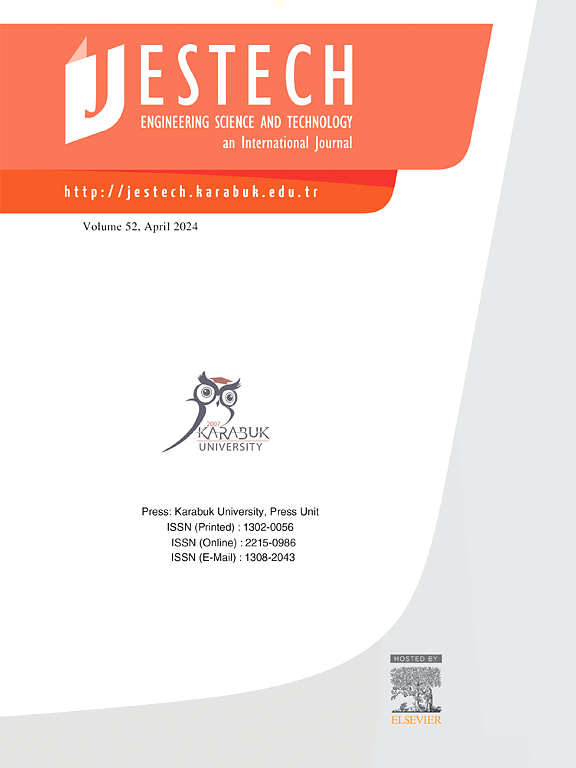Enhancement in the electrical efficiency of a photovoltaic thermal system through ternary nanofluids application: Nanomaterial shape effects and phase change material encased in a rectangular block
IF 5.1
2区 工程技术
Q1 ENGINEERING, MULTIDISCIPLINARY
Engineering Science and Technology-An International Journal-Jestech
Pub Date : 2025-01-01
DOI:10.1016/j.jestch.2024.101919
引用次数: 0
Abstract
This research investigates the enhancement of electrical efficiency in a photovoltaic thermal (PV/T) system by utilizing water-based ternary hybrid nanofluids and incorporating a phase change material (PCM) within the flow channel. The system comprises a glass cover, a silicon layer, and a copper absorber, beneath which a flow channel contains a block filled with Paraffin Octadecane Wax (C18H38) as the PCM. The analysis is conducted using COMSOL Multiphysics 6.0, applying a conjugate heat transfer interface to simulate the interaction between conduction and forced convection within the solid and liquid domains. The study explores the phase transition behavior of the PCM, the thermal dynamics, and the electrical efficiency of the PV/T system under varying Reynolds numbers (50 to 150) and different nanomaterial shapes, including spherical, bricks, cylindrical, platelets, and blades. The simulations consider equal volume fractions of copper, alumina, and multi-walled carbon nanotubes (MWCNT) in the nanofluid, with total volume fractions ranging from 1 % to 10 %. Results reveal that blade-shaped nanoparticles significantly enhance the phase transition rate of paraffin, achieving an average phase transition of 81.97 % at Reynolds number 50 and 10 % volume fraction. Furthermore, the temperature variation along the PCM block shows rapid behavior with blade-shaped particles. Optimal electrical efficiency, reaching a peak of 9.42 %, is observed at Reynolds number 150 and 10 % volume fraction with blade-shaped nanoparticles. The study underscores the importance of nanoparticle shape and volume fraction in improving PV/T system performance. The findings recommend blade-shaped nanoparticles and higher nanofluid volume fractions to maximize electrical efficiency. This work provides valuable insights into the potential of ternary hybrid nanofluids and phase change materials for advancing PV/T technology.
求助全文
约1分钟内获得全文
求助全文
来源期刊

Engineering Science and Technology-An International Journal-Jestech
Materials Science-Electronic, Optical and Magnetic Materials
CiteScore
11.20
自引率
3.50%
发文量
153
审稿时长
22 days
期刊介绍:
Engineering Science and Technology, an International Journal (JESTECH) (formerly Technology), a peer-reviewed quarterly engineering journal, publishes both theoretical and experimental high quality papers of permanent interest, not previously published in journals, in the field of engineering and applied science which aims to promote the theory and practice of technology and engineering. In addition to peer-reviewed original research papers, the Editorial Board welcomes original research reports, state-of-the-art reviews and communications in the broadly defined field of engineering science and technology.
The scope of JESTECH includes a wide spectrum of subjects including:
-Electrical/Electronics and Computer Engineering (Biomedical Engineering and Instrumentation; Coding, Cryptography, and Information Protection; Communications, Networks, Mobile Computing and Distributed Systems; Compilers and Operating Systems; Computer Architecture, Parallel Processing, and Dependability; Computer Vision and Robotics; Control Theory; Electromagnetic Waves, Microwave Techniques and Antennas; Embedded Systems; Integrated Circuits, VLSI Design, Testing, and CAD; Microelectromechanical Systems; Microelectronics, and Electronic Devices and Circuits; Power, Energy and Energy Conversion Systems; Signal, Image, and Speech Processing)
-Mechanical and Civil Engineering (Automotive Technologies; Biomechanics; Construction Materials; Design and Manufacturing; Dynamics and Control; Energy Generation, Utilization, Conversion, and Storage; Fluid Mechanics and Hydraulics; Heat and Mass Transfer; Micro-Nano Sciences; Renewable and Sustainable Energy Technologies; Robotics and Mechatronics; Solid Mechanics and Structure; Thermal Sciences)
-Metallurgical and Materials Engineering (Advanced Materials Science; Biomaterials; Ceramic and Inorgnanic Materials; Electronic-Magnetic Materials; Energy and Environment; Materials Characterizastion; Metallurgy; Polymers and Nanocomposites)
 求助内容:
求助内容: 应助结果提醒方式:
应助结果提醒方式:


